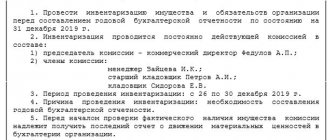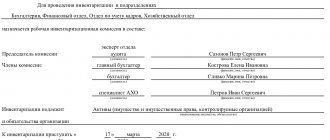O.I. Prokhorova author of the article, Ascon consultant on accounting and taxation
All organizations are required to conduct an inventory before drawing up annual financial statements (Part 2, Article 11 of the Federal Law of December 6, 2011 N 402-FZ, clauses 26, 27 of the Regulations on Accounting and Financial Reporting, approved by Order of the Ministry of Finance of Russia dated July 29, 1998 N 34n (hereinafter referred to as Regulation No. 34n), clause 27 of the Guidelines for inventory of property and financial obligations, approved by Order of the Ministry of Finance of Russia dated June 13, 1995 N 49 (hereinafter referred to as Guidelines for Inventory), clause 38 PBU 4/99, Appendix to the Letter of the Ministry of Finance of Russia dated 01/19/2018 N 07-04-09/2694, Appendix to the Letter of the Ministry of Finance of Russia dated 01/09/2013 N 07-02-18/01).
The purpose of the annual inventory is to identify the actual availability of property, compare it with accounting data, check the completeness of the reflection of liabilities in accounting, ensure the reliability of accounting data and financial statements (clause 1.4 of the Inventory Guidelines).
When an inventory is NOT necessary
At the end of each year, you should check whether the accounting data corresponds to the actual presence of assets and liabilities. Property and liabilities recorded off the balance sheet are also subject to inventory (paragraph 2, clause 1.3, clause 3.7 of the Inventory Guidelines).
In fact, property located in the organization that is not accounted for for any reason is also subject to inventory and subsequent acceptance for accounting (paragraph 2, clause 1.3 of the Methodological Instructions for Inventory).
However, before drawing up annual reports, it is not necessary to check the condition of property, the inventory of which was carried out after October 1 of the reporting year. In this way, the inventory can be evenly distributed over the entire fourth quarter. Or an unscheduled audit due to a change in the financially responsible person may be accepted for the purpose of summing up the results of the year.
In addition, an inventory of fixed assets can be carried out once every three years, and of library collections - once every five years. For example, if an organization checked fixed assets in the 4th quarter of 2019, you don’t have to do this again until the 4th quarter of 2022 (clause 27 of Regulation No. 34n and Inventory Guidelines).
Property inventory
The actual availability of property is verified by counting, weighing and measuring it, always in the presence of financially responsible persons.
Goods and materials stored in packaging are checked against documents and some of them are opened. All packages do not need to be opened for inspection.
Features of the inventory of certain types of property and obligations of the organization are described in detail in section 3 of the Methodological Instructions for Inventorying Property...” (approved by Order of the Ministry of Finance of the Russian Federation dated June 13, 1995 No. 49).
Let us reflect in the table the features of the inventory of some property.
| Inspected property (liabilities) | Check Features |
| Fixed assets |
|
| Intangible assets (IMA) | Checked:
|
| Financial assets |
|
| Inventory |
|
| Work in progress and deferred expenses |
|
| Cash, cash documents and BSO |
|
Inventory procedure
The inventory before drawing up the annual financial statements is planned and is carried out in the manner established by the internal documents of the organization. This may be an inventory provision, which is part of the accounting policy in accordance with clause 4 of PBU 1/2008, or another administrative document signed by the head (Letter of the Ministry of Finance of Russia dated 01/09/2020 N 07-01-09/73).
The inventory regulations usually indicate:
- when an inventory is required;
- timing of inventory in the context of property and liabilities;
- document forms used to document inventory results.
When conducting an inventory before preparing annual financial statements, the following general procedure should be followed:
- drawing up a schedule of control activities;
- execution of an order for the appointment of a working inventory commission indicating the place, time and volume of inventory (Resolution of the State Statistics Committee of the Russian Federation dated August 18, 1998 N 88 “On approval of unified forms of primary accounting documentation for recording cash transactions, for recording inventory results”);
- receiving receipts from financially responsible persons (clause 2.4 of the Inventory Guidelines);
- checking the presence and condition, as well as assessing assets and liabilities using the continuous method (clauses 2.7, 2.8 of the Inventory Guidelines);
- checking the availability and storage conditions of documents confirming the location of assets in the ownership or disposal of the organization, as well as technical documentation (clause 3.2 of the Inventory Guidelines);
- identification of assets subject to write-off (clauses 3.6, 3.25, 3.26 of the Inventory Guidelines);
- checking assets for impairment (clause 35 of PBU 4/99);
- identification of doubtful and bad debts (clause 3.8 of the Inventory Guidelines);
- summing up the inventory and processing documents (Resolution of the State Statistics Committee No. 88);
- reflection of inventory results (clause 5.5 of the Inventory Guidelines).
The essence of inventory in a budgetary institution
Inventory involves checking the availability and condition of property as of a specified date and the compliance of such information with the accounting data carried out in a budgetary institution. The essence of inventory is to compare factual and accounting information with each other and identify mistakes of accountants or financially responsible persons, correct them in the reporting period and prevent them in the future. An inventory is also necessary in cases where the theft and misappropriation of state property by the guilty party is suspected.
Inventory is required when certain situations occur, which include:
- reorganization of the institution;
- change or dismissal of financially responsible persons;
- preparation of annual financial and accounting statements;
- suspicions of theft or theft;
- emergency due to a natural disaster.
Summing up the inventory
To formalize the results of the inventory, it is necessary to fill out inventories, acts, statements, using standardized forms (clause 2.10 of the Methodological Instructions for Inventory, Resolution of the State Statistics Committee No. 88). Identified surpluses or shortages are entered into the comparison sheets (forms INV-18 and INV-19) and the list of results identified by the inventory (form INV-26). Based on the results of the annual inventory, the commission usually draws up a protocol.
The presence and correct execution of inventory documents is necessary both to reflect the results in accounting and to resolve disputes if they arise.
The results of the annual inventory are reflected in the annual financial statements (clause 5.5 of the Inventory Guidelines).
Documents before and after the inventory
The main documents that are drawn up before the inventory and after its actual implementation should include:
| Document | Description |
| Order to conduct an inventory in a budgetary institution (form INV-22) | Published by the head of the organization 10 days before the event and involves highlighting the main points of the audit |
| Inventory list (INV-1 form, INV-3 form) | Compiled on the basis of data from the actual recount and census of the institution’s property and contains the name, inventory numbers (if available) and quantitative expression of objects |
| Matching statement (form INV-18) | Compiled when actual and accounting data differ on any audit items |
| Additional documents | Can be compiled if necessary, when you need to additionally decipher the data or create explanations |
| Inventory order | The manager, on the basis of inventory documents, issues an order on the results of the event, as well as an order to bring to justice all identified perpetrators |
Capitalization of surplus
Assets found to be in surplus are subject to capitalization and credited to the financial results of the organization (clause 5.1 of the Methodological Instructions for Inventory).
In tax accounting, surpluses are included in non-operating income at market value (clause 8, clause 20 of Article 250 of the Tax Code of the Russian Federation, Letter of the Ministry of Finance of Russia dated September 11, 2020 N 03-11-06/2/80113). The market value is determined taking into account the provisions of Art. 105.3 of the Tax Code of the Russian Federation (clause 5 and article 274 of the Tax Code of the Russian Federation, Letter of the Ministry of Finance of Russia dated August 28, 2020 N 03-03-06/1/75787). Depreciation can be calculated on capitalized fixed assets, but bonus depreciation cannot be applied.
Inventory and materials are taken into account as usual. This property may be written off or sold. As for sales, the income received as a result of such transactions is reduced by the amount of the market value of the property being sold (accounted for as non-operating income), at which it was accepted for accounting (clause 2, clause 1, article 268 of the Tax Code of the Russian Federation, Letter of the Ministry of Finance of Russia dated September 23 .2011 N 03-03-06/1/583, dated 02/11/2011 N 03-03-06/1/88, Resolution of the Federal Antimonopoly Service of the Moscow Region dated 02/21/2013 in case N A40-2055/12-20-9).
Write-off of shortages
Shortages within the limits of the norms approved by law are written off by order of the manager as production and distribution costs (clause 5.1 of the Inventory Guidelines).
In tax accounting, non-operating expenses take into account shortages of material assets in production and warehouses, at trading enterprises in the absence of culprits, as well as losses from theft, the culprits of which have not been identified. In these cases, the fact of the absence of perpetrators must be documented by an authorized government body (clause 5, clause 2, article 265 of the Tax Code of the Russian Federation).
The norms of the Tax Code of the Russian Federation do not contain instructions on what specific documents need to be obtained in order to confirm the absence of guilty persons, and thus does not limit the taxpayer in confirming the legality of accounting for relevant expenses (Letter of the Ministry of Finance of the Russian Federation dated December 8, 2017 N 03-03-06/ 1/81919).
Documentary evidence may be, in particular, a copy of the resolution of the investigator of the internal affairs bodies of the Russian Federation on the suspension of the preliminary investigation in a criminal case due to failure to identify the person to be brought as an accused (clause 1, paragraph 1, article 208 of the Code of Criminal Procedure of the Russian Federation, Letters of the Ministry of Finance of Russia from 16.12.2011 N 03-03-06/4/149, dated 03.08.2011 N 03-03-06/1/448).
If the guilty person is discovered, then a claim for compensation for losses from the theft of funds can be presented by the organization to the guilty person in accordance with the civil legislation of the Russian Federation. Amounts received to compensate for losses are non-operating income (clause 3 of Article 250 of the Tax Code of the Russian Federation), and the cost of lost property is an expense (clause 20 of clause 1 of Article 265 of the Tax Code of the Russian Federation, Letter of the Ministry of Finance of the Russian Federation dated August 27, 2014 N 03- 03-06/1/42717).
Documentation of inventory
How to draw up an order for an inventory?
Carrying out an inventory begins with issuing an order to carry it out. It, in addition to other mandatory details, indicates: the date on which the inventory is carried out, the timing of its implementation, the types of assets and liabilities being inventoried. The same order often approves the composition of working inventory commissions. For an example of an order, see “Taxes and Accounting”, 2021, No. 94, p. 10.
At the same time, remember! The timing and procedure for conducting an inventory, including an annual one, can be established in the order on the organization of accounting or in the order on accounting policies. In this case, there is no need to issue an order to conduct an annual inventory. It is sufficient, immediately before its start, to approve the composition of the working inventory commissions by a separate order from the manager.
What documents are used to document the results of the inventory?
During the inventory, the working inventory commission draws up ( clause 15 of section II of Regulation No. 879
):
— inventory records , which record the presence, condition and valuation of the enterprise’s assets and assets owned by other enterprises and recorded off the balance sheet;
— inventory acts , which show the presence of monetary documents, strict reporting document forms, financial investments, cash, as well as the completeness of the reflection of funds in bank accounts (registration accounts), receivables and payables, liabilities, targeted financing funds, expenses and income future periods, provisions (reserves) created in accordance with the requirements of P(S)BU, IFRS
and other acts of legislation.
Upon completion of the inventory, the completed inventory lists (inventory acts) are transferred by the commission to the accounting department. Here, all calculations carried out by the working inventory commission in the inventory lists are checked and in case of discrepancies (surpluses or shortages) between the data of the inventory lists (inventory acts) and the accounting data, comparative statements of assets and liabilities ( clause 20 of section II of Regulation No. 879
).
And finally, the inventory commission formalizes the inventory results with an inventory protocol . It cites ( clause 1, section IV of Regulation No. 879
): inventory results, conclusions about identified discrepancies between the actual availability of assets and liabilities and accounting data, the causes of shortages, losses and surpluses, proposals for offsetting shortages and surpluses by re-grading, proposals for writing off shortages within the limits of natural loss norms, as well as excess shortages and losses from damage to valuables, indicating the reasons and measures taken to prevent such losses and shortages, and other essential information.
The protocol of the inventory commission, together with other “inventory” documents, is submitted to the manager for approval.
The manager approves the protocol within 5 working days after completing the inventory
Based on the approved protocol, the inventory results are reflected in the accounting and financial statements of the period in which it was completed.
Write-off of bad debts
Bad debts are written off on the basis of an inventory of payments (form INV-17) and an order from the manager (clause 77 of the Accounting Regulations No. 34n, Article 266 of the Tax Code of the Russian Federation, Letter of the Ministry of Finance of Russia dated December 27, 2018 No. 03-03-06/1/ 95709, dated 10/13/2017 N 03-03-06/1/67057, dated 07/11/2017 N 03-03-06/1/43877).
Uncollectible accounts receivable are subject to write-off against the allowance for doubtful debts. If the reserve is not enough, the remaining debt goes to expenses (Article 265 of the Tax Code of the Russian Federation, Letter of the Ministry of Finance dated January 16, 2018 N 03-03-06/2/1551). In accounting, all organizations are required to create such a reserve; in tax accounting, this is the right of the organization (clause 70 of Regulation No. 34n, Article 266 of the Tax Code of the Russian Federation, Letter of the Ministry of Finance of Russia dated August 31, 2020 No. 03-03-06/2/76195).
The receivable is subject to write-off as expenses along with VAT (Article 266 of the Tax Code of the Russian Federation, Letter of the Ministry of Finance dated October 21, 2008 N 03-03-06/1/596). According to the Ministry of Finance, when writing off debts on advances issued, the VAT accepted for deduction from this advance payment must be restored (Letter of the Ministry of Finance dated January 28, 2020 N 03-07-11/5018).
After write-off, bad receivables are reflected in off-balance sheet account 007 for five years (clause 77 of Regulation No. 34n).
Under the simplified tax system, written-off receivables are not taken into account either in expenses or in income (Letters of the Ministry of Finance dated 02/20/2016 N 03-11-06/2/9909, dated 07/22/2013 N 03-11-11/28614).
Bad accounts payable are taken into account as income under both the OSNO and the simplified tax system (clause 78 of Regulation No. 34n, clause 2, clause 1, article 248, clause 18, article 250, clause 1, article 346.15 of the Tax Code of the Russian Federation). If an organization uses the simplified tax system to write off the creditor for the advance received from the buyer, then no income will arise, because income is reflected as the advance payment is received (clause 1 of Article 346.17 of the Tax Code of the Russian Federation, Letter of the Ministry of Finance of Russia dated March 14, 2016 N 03-11-06/2/14135).
Writing off accounts payable to the supplier does not oblige the buyer to restore VAT previously accepted for deduction (Letter of the Ministry of Finance dated June 21, 2013 N 03-07-11/23503). When a creditor writes off an advance received, the VAT calculated on it cannot be deducted. There is no need to include it in income or expenses (Article 248 of the Tax Code of the Russian Federation, Letter of the Ministry of Finance dated December 7, 2012 N 03-03-06/1/635).
Compliance of the object with the concept of “Asset”
One of the tasks of inventory is to check objects for compliance with the concept of “Asset” * (3). Objects of fixed assets for which it has been established that further operation, repair, restoration are ineffective (non-compliance with asset criteria) are subject to reflection on off-balance sheet account 02 “Tangible assets accepted for storage” until the functional purpose of the specified property is further determined (involvement in economic circulation, sale or write-off ). No further depreciation is charged on these property items.
More on the topic: Insurance premiums from 2021: 5 important innovations
The decision that objects do not correspond to the concept of “Asset” can be made by the inventory commission * (4). In this case, the inventory commission draws up an Act on the results of the inventory (f. 0504835), which serves as the basis for the disposal of fixed assets from the balance sheet. Based on the decisions made by the commission, the accounting department draws up an Accounting Certificate (f. 0504833), which reflects accounting records on the disposal of fixed assets from the balance sheet while simultaneously reflecting information about the specified property items on off-balance sheet account 02 “Tangible assets accepted for storage.”
Despite the definitions of “Asset” given in regulatory documents and the explanations of financial department specialists on this topic, officials of institutions periodically encounter ambiguous situations. Let's look at some of them and possible solutions:
- The institution has property that cannot be used in its activities. For example, equipment for the provision of any specific government services, which the institution no longer provides this year according to the assignment. To decide on the need to transfer property to off-balance sheet account 02 due to inconsistency with the concept of “Asset”, in this situation it is necessary to assess the potential use of the property. If it exists, then the object corresponds to the concept of “Asset” and there is no need to transfer it to off-balance sheet account 02. For example, this property can be sold, exchanged for other assets, etc., that is, it has useful potential *(5). It would also be advisable to return it to the owner (including at the initiative of the institution), if we are talking about property previously assigned to the institution.
- Officials of the institution made a decision about the impossibility of further exploitation of the property and carrying out repair and restoration work in relation to it. The object is planned for decommissioning, but it must be properly approved. In such a situation, the property may be recognized as not corresponding to the concept of “Asset”, written off from the balance sheet and reflected in off-balance sheet account 02 for the period of approval.
- The institution contains property received as a result of replacing a component of the equipment, while the functional purpose (for use, sale, etc.) is not defined. Financial department specialists*(6) indicate that such property is accounted for in off-balance sheet account 02.
More on the topic: Group accounting of fixed assets in budgetary institutions from January 1, 2021
Features of the annual inventory in 2021
When conducting an inventory before preparing reports for 2020, you should take into account the latest changes in accounting legislation.
From 2021, a new accounting standard will be mandatory.
Two standards have been approved, the application of which is mandatory from reporting for 2022, but if you wish, you can switch to the new rules earlier: FSBU 6/2020 “Fixed Assets” and FSBU 26/2020 “Capital Investments” (Order of the Ministry of Finance of Russia dated September 17, 2020 N 204n ).
This may require the organization to take a more thorough approach to checking and reflecting balances in accounting and reporting.
In addition, at the end of 2021, settlements with accountable persons and inventory of balances on account 71 deserve special attention.
This is due to the forced cancellation of business trips due to coronavirus restrictions and the need for many taxpayers to adjust their plans.
Preparing for an inspection at a budget institution
Before carrying out an inventory in a budgetary institution, it is necessary to decide on the objects that will be subject to inspection. In this case, the audit can be complete (absolutely all assets of the organization are rewritten and counted) or selective (a specific area of accounting is analyzed).
Objects that can be inventoried in a budgetary institution include:
| An object | A comment |
| Fixed assets | Tangible assets that are used for a period of more than a year without changing their physical characteristics and parameters (see → the procedure for conducting an inventory of fixed assets in 2021) |
| Material reserves | Tangible assets that are used for a period of up to one year and at the same time change their form |
| Calculations with accountable persons | Calculations for transactions related to the provision of funds for reporting with the subsequent preparation of an advance report and the attachment of relevant supporting documents to it |
| Cash | All funds in cash and non-cash form |
| Settlements with suppliers or contractors | Settlements for transactions related to the acquisition of inventory items or the order of any work and services. |
With a mandatory annual inventory inspection, absolutely all objects are subject to inventory, and with an unscheduled inspection, only those objects that require a more careful and thorough analysis.
Before the audit, the head of the budgetary institution is obliged to issue an order that will cover all the main points of this event, including:
- composition and chairman of the inventory commission;
- objects of audit;
- the reason for the inventory;
- timing of this procedure.
In addition, the accounting department is obliged to record all primary documents on the receipt and write-off of inventory and cash in accounting so that it fully reflects the real picture of the financial position of the budgetary institution. This also applies to financially responsible persons - they must also prepare all the necessary documentation and submit it to the accounting department for processing.
Penalty for failure to take inventory
The tax inspectorate or other government agencies cannot fine an organization simply because it did not conduct an annual inventory. There is no such fine in the law.
However, without inventory:
- it is impossible to obtain a positive audit opinion;
- accounting statements may be unreliable, which entails fines both for the organization itself and for its officials (Article 120 of the Tax Code of the Russian Federation; Article 15.11 of the Code of Administrative Offenses of the Russian Federation);
- errors in tax accounting, additional charges of taxes, penalties and fines are possible (Articles 75, 120, 122 of the Tax Code of the Russian Federation).









